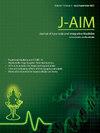在埃利希腹水小鼠模型中,Swarna Bhasma降低肿瘤特异性信号的血液浓度并保护肝细胞免受损伤
IF 1.9
Q3 INTEGRATIVE & COMPLEMENTARY MEDICINE
引用次数: 0
摘要
全球癌症发病率高得惊人,这种范式转变鼓励了焚烧金纳米粉末的应用,因为它具有非凡的效力、可负担性和最小的毒性作用。目的探讨sbc对小鼠血液中肿瘤相关标志物的影响及sbc对肝脏参数的影响。方法将雌性瑞士白化小鼠seac (Ehrlich’s as腹水癌)诱导的肿瘤分为6组,分别为载体对照组(VC)、疾病对照组(DC)、标准对照组(SC)和剂量递增治疗组(1.95,3.9,测定血清CEA(癌胚抗原)、TNF-α(肿瘤坏死因子α)、IL-6(白细胞介素-6)、ALT(谷丙转氨酶)、AST(天冬氨酸转氨酶)水平。对每日食物摄入量、体重和肿瘤体积(用游标卡尺)的变化进行了连贯的研究和分析。数据分析采用单因素方差分析和Tukey's Honest显著性检验。结果高剂量b能有效降低CEA水平,中剂量b能有效降低TNF-α水平。中等剂量和高剂量均表现出明显的剂量依赖性IL-6水平下降。此外,SB导致AST/ALT比率呈剂量依赖性降低。据报道,在中等和高剂量的SB中,肿瘤体积显著减少,厌食症明显改善。高剂量SB在肝、肾和脾组织中显示出血清验证的结果。结论SB的抗癌作用呈剂量依赖性。该发现还强调了低剂量SB通过减轻癌症相关肝损伤而具有肝保护能力本文章由计算机程序翻译,如有差异,请以英文原文为准。
Swarna Bhasma reduces the blood concentration of tumor-specific signatures and protects from hepatocellular damages in Ehrlich ascites mice model
Background
The paradigm shift with alarmingly high rate of global cancer incidences encourages the application of incinerated gold Nano powder, Swarna Bhasma (SB) due to its exceptional potency, affordability, and minimal toxic effects. Previous experimental investigations were unable to provide a biochemical understanding of the anti-carcinogenic properties of SB.
Objective
To evaluate the tumour related markers in blood and possible alteration in hepatic parameters due to SB.
Methods
EAC (Ehrlich’s Ascites Carcinoma) induced tumour was generated in the female Swiss albino mice divided into 6 groups, namely, Vehicle Control (VC), Disease Control (DC), Standard Control (SC), and Treatment Groups with escalating doses (1.95, 3.9, and 7.8 mg/kg body weight) of SB. Blood serum quantified was measured for the levels of CEA (Carcinoembryonic antigen), TNF-α (Tumour Necrosis Factoralpha), IL-6 (Interleukin-6), ALT (Alanine transaminase), and AST (Aspartate aminotransferase). Changes in daily food consumption, body weight, and tumour volume (with Vernier caliper) were coherently studied and analysed. The data was analysed using One-Way ANOVA and Tukey's Honest Significance Test.
Result
SB demonstrated effective reduction of CEA levels at higher doses, and TNF-α levels at medium doses. Both moderate and high doses exhibited a noteworthy, dosedependent decrease in IL-6 levels. Furthermore, SB led to a dose-dependent reduction in the AST/ALT ratio. A significant reduction in tumour volume were reported in both the moderate and high doses of SB along with marked improvement in anorexia. The higher doses of SB exhibited the serum validated results in the hepatic, renal and the splenic tissues.
Conclusion
The anti-carcinogenic activity of SB appeared to be dose-dependent. The finding also underscored the hepato-protective capability of SB in lower dose by alleviating cancer-related liver damage
求助全文
通过发布文献求助,成功后即可免费获取论文全文。
去求助
来源期刊

Journal of Ayurveda and Integrative Medicine
INTEGRATIVE & COMPLEMENTARY MEDICINE-
CiteScore
4.70
自引率
12.50%
发文量
136
审稿时长
30 weeks
 求助内容:
求助内容: 应助结果提醒方式:
应助结果提醒方式:


